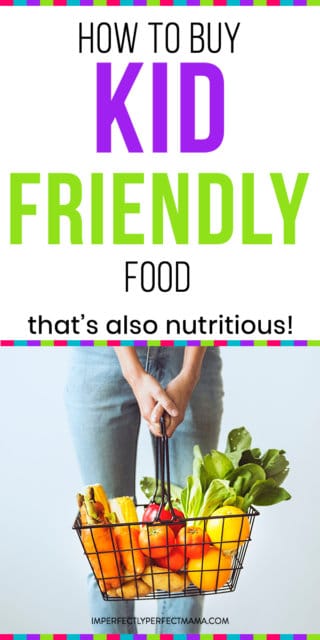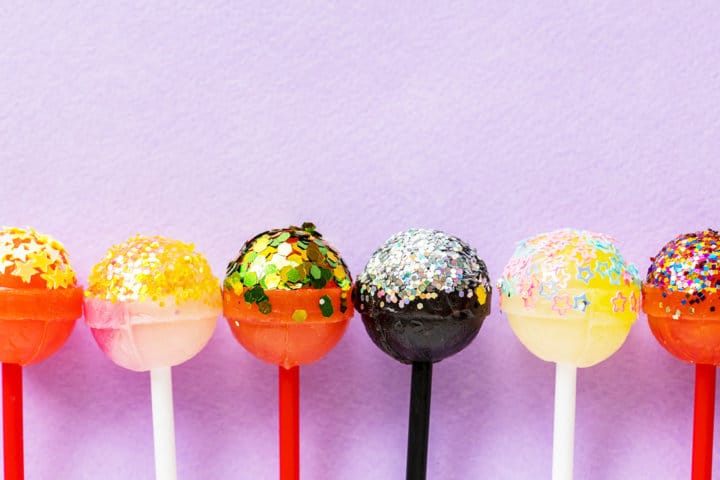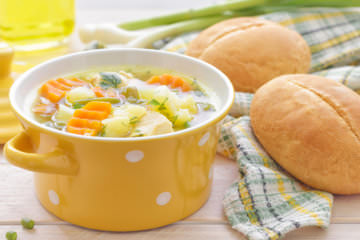Have you ever been locked in a battle of wills in the cereal aisle at the grocery store?

One day my four-year-old saw a commercial for Froot Loops.
All was well . . . until we entered the cereal aisle on our next grocery trip. As soon as she spotted the bright box, the begging was on.
I’m reluctant to by a big box of sugary, food coloring laced product for my kiddos.
I want them to learn healthy eating now, so they will grow up with good habits. I’m not the only one to feel this way, right moms and dads?
In this case I knew right away that this was not a food I wanted to buy.
Sometimes we are not so lucky.
In the heat of the moment, how do you decide whether to give in and buy the latest craving or put up a fight for nutrition?
In desperation I scanned the cereal aisle for a healthier choice as the whining grew more insistant. My eyes settled on a fruit flavored box of Cheerios.
A quick look at the label and I saw that the Fruity Cheerios are colored with fruit and vegetable juices instead of red 40, yellow 6, and blue 1.
While it still has sugar, it also uses pear puree concentrate as a sweetener. I wouldn’t call them a health food, but they are definitely an upgrade over Froot Loops.
Nutrition Label 101

I’d like to help you become a nutrition label pro when you go grocery shopping.
I know, I know, you’re saying, “No mom has time for that!” Those labels are long and full of numbers. Some of them are percentages, others are grams and milligrams.
But believe me, it doesn’t have to be hard and it doesn’t take long.
Once you’ve learned my nutrition label 101 you’ll be able to glance at the package and quickly spot the biggest enemies to good health. I’ll also share some upgrades I’ve made to give my kids what they ask for without sacrificing good nutrition.
Here are my best tips, tricks, and hacks for choosing healthy and kid friendly food. Let the nutrition label be the tool it was meant to be.
How to Spot the Worst Enemies to Good Nutrition
First, it helps to know the anatomy of a nutrition label. It’s the rectangular shaped section, usually white, and usually located on the back or side panel titled “Nutrition Facts”.
1. Enemy: Too Much Fat
Nutritionists recommend that no more than 20% of the calories we eat in a day come from fat.
If you’re like me, counting calories all day is not going to happen. You’re going to love my first hack.
At the top of the nutrition facts label you will see calories per serving and just under that, calories from fat. Simply divide calories from fat by total calories and you will get the percent of fat in that food.
For example, a favorite cereal bar of ours, Clif Kid Chocolate Brownie Organic Z bar, has 35 calories from fat and 130 calories per bar. 35÷130=.2692 or approximately 27% fat. A little over the daily allowance, but close!
2. Enemy: Added sugar

According to the American Heart Association, children should eat less than 6 teaspoons or 25 grams of sugar per day.
The typical American child eats triple the recommended amount of added sugars. Eating too much sugar is linked to obesity, high blood pressure, and type 2 diabetes.
I don’t want my family to have to cope with any of those. So how do you keep tabs on their sugar intake?
This is one of the trickiest things to control because kids LOVE sweets. Most of the sugar kids consume is added to sweet products during processing, not from our sugar dish at home.
It’s not like we can count the teaspoons as they put them in their mouth.
Knowing the number of teaspoons in a serving of a product is invaluable! Here’s how to do it:
Four grams of sugar equal a teaspoon. To find the amount of sugar per serving, look for the bold heading Total Carbohydrate.
Under that heading there will be two subheadings, dietary fiber and total sugars in grams. Divide the grams of sugar by 4 and you know how many teaspoons they would be getting.
Using those same bars as an example, one bar has 11 grams of sugar. 11÷4=2.75 or 2 3/4 teaspoons.
That is a HUGE improvement over a Hershey’s milk chocolate bar at 24 grams or 6 teaspoons.
Drinks, especially the ones kids like, are a big culprit. I learned that the hard way.
One time I got my little one a chocolate milk and then I couldn’t figure out why she was instantly bouncing off the walls and singing at the top of her lungs.
I was shocked when I checked the label and it had 48 grams of sugar in the individual sized jug. That’s 12 teaspoons, enough for 2 whole days!
An 8oz. serving of fruit juice has 6 1/2 teaspoons of sugar. One day’s allotment, gone in a gulp.
3. Enemy: Additives
Many products contain additives to add flavor or color or preserve freshness. Although the verdict is still out about how much these ingredients influence our health and in what ways, my philosophy is to avoid them whenever possible.
If there are any detrimental effects, they probably have a greater effect on smaller, developing bodies.
Additives are usually very easy to spot.
Most often you will find them at the bottom of the ingredients list.
I watch out for sodium nitrate in deli meats and hot dogs, artificial colors in breakfast cereals, candies, and drinks, and monosodium glutamate and artificial colors in crackers and chips.
Now you know how to spot the 3 most common enemies to nutrition on the “Nutrition Facts” label.
Armed with that information, you can quickly scan a product and decide whether to toss it in your cart or put it right back on the shelf.
Here are a few of my findings while fighting the healthy food war. Hopefully these easy upgrades will have your pantry looking healthier in no time.
Easy Upgrades for Kid Food Favorites
1. Hot dogs
Oscar Mayer makes a nitrate free classic hot dog and turkey dog. Just look for the word “uncured” on the front of the packaging.
2. Candy Bars
A great way to upgrade a chocolate bar is to swap it with a cereal bar.
Chocolate candy bars are high in fat and sugar with very little nutritional value. Instead of letting my girls eat one every day, we save them for special occasions and use cereal bars as a sweet treat.
The cereal bar aisle is one of the biggest in the supermarket, and believe me they are not all created equal.
To help you out I did a little comparison shopping.
Pop Tarts are a poplar breakfast cereal bar, but they contain a whopping 16 grams of sugar in one pastry.
Pop quiz, how many teaspoons is that? That’s right, 4 teaspoons, down the hatch.
Only slightly better than the 6 teaspoons in a chocolate bar. The only healthy ingredients in them are dried cherries and dried apples, but they are buried under a list of sugar synonyms and followed up with a list of artificial colors.
Right now Kind Healthy Grains bars are the favorite in our house, even more than the Clif Kid Z bars mentioned earlier to demonstrate the math.
And I’m OK with that because the first ingredient on the list is a whole grain blend, and some of the sweetness comes from apple, blueberry and plum puree. The total sugar in one bar is 1 3/4 teaspoons.
By choosing the Kind bar over a chocolate bar, we are cutting out 4 1/4 teaspoons of sugar!
3. Chips
When it comes to salty treats, most of them have about 30% fat.
A good rule of thumb is to look for a short ingredient list. Doritos, with a huge list including both MSG and artificial colors is probably among the worst in the spectrum of salty treats.
The serving size is only 12 chips, but who ever stops after eating only 12!
A better bet is Smartfood White Cheddar popcorn. It’s a little higher in fat than Doritos at 36%, but one serving is 1 3/4 cups.
Much more satisfying than 12 chips, am I right? Even better, find a popcorn with no cheesy coating and it could drop the fat percentage right down.
Another good option; Goldfish crackers with a serving size of 55 crackers, and only natural coloring.
The absolute best choice for a salty treat are pretzels. Snyders Snap pretzels have . . . wait for it . . . drum roll please . . . 3% fat and a serving is 24 pieces.
4. Soda
Soda, KoolAid, and other sugary beverages are a very rare treat for our girls.
In fact we haven’t even allowed any caffeinated or colored sodas yet. Instead we love to buy 100% fruit juice and fill our glass half and half with juice and seltzer water.
Many of the girls’ friends have started liking our soda stand-in.
The most important thing is to make sure you are buying real fruit juice.
Many bottles in the supermarket juice aisle actually only have between 5% and 20% fruit juice. To find out, look just above the nutrition facts section on your juice label.
In small letters you will find the percentage of fruit juice in that product. One of our favorites is Juicy Juice. We love the Fruit Punch or Berry Blend.
Of course the best upgrade to drinking soda is to have a glass of water and eat a piece of fruit!
As for the chocolate milk problem, I started keeping a bottle of chocolate syrup in the refrigerator and mixing it with milk on my own.
I figured at least that way I could count the teaspoons of sugar as I stirred them in myself.
Supermarket Savvy
I hope you have been able to turn my supermarket struggles into your new and improved supermarket savvy!
Next time your kids start begging, be a nutrition facts ninja.
Scan for the percentage of calories from fat, quickly calculate how many teaspoons of sugar that product will add to your day, and check the ingredients list for chemical additives.
The only tools you need are the nutrition facts label and your math brain. Or if you’re like me, just use the calculator on your phone.




Leave a Reply